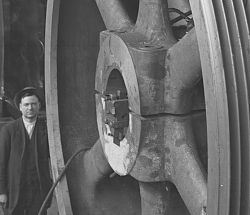don't tell Osha lol.



Mesta Machine Company rope drive wheel. Homestead, PA. 1905/1925.
Fullsize image: https://diqn32j8nouaz.cloudfront.net...l_fullsize.jpg


New plans added on 11/22: Click here for 2,593 plans for homemade tools.
yup I saw that somewhere I visited. them smart fellers, split the power to any where in the factory.up down over change ratio for something I was amazed whay all they had done with it many many years ago. the down side is...when the power head stops it all stops. but there are addvantages to just one power unit, like put it outa the way.heat,noise etc.
What am I missing?
I am looking at that massive "wheel" which appears to be cast in one piece. The hub is bored and spilt. They appear to be cutting the keyway. There appears to be 4 bolts to clamp the hub to the shaft by squeezing the 2 halves of the hub together. Each half of the hub is attached to the outer rim rim of the wheel by 3 stout spokes.
Something has to move when they squeeze that hub down onto the shaft. Does it flex that massive wheel?

Exactly right, but only the hub, there aren't spokes across the center.
The cutter head has a tapered arrangement with set screws to control depth. Boring a split hub is common, the gap is shimmed and clamped, the same torque on fasteners secures on shaft at installation.
It looks like a boring mill, so must be using the quill Z axis as a broach, like a lathe chucked part, cutter driven by carriage. Possibly, that era had a mechanism to run the quill in and out without rotating spindle?
However, can't imagine a spindle within a square quill, I believe the machine is a shaper.
An alternative would Z the table; but this is a floor machine, not table type. Floor machines are considered 'portable', they secure the column at the part, the 'floor' actually is a giant Tee slotted plate. Dialing in a part, isn't a couple handles like a Bridgeport.
Along with all that, the bore could have been done in a vertical lathe. The casting has been turned, those grooves ain't cast, an concentricity included. Biggest I've heard of was 33'; if man in picture is 5'5'', that's an 16' to 18' sheave.
But, here's a 42' Industrial History: Big Machine Tools
https://newatlas.com/the-citroen-che...3868/?amp=true
Last edited by Toolmaker51; Jul 25, 2022 at 02:25 PM. Reason: extra helping of links
Sincerely,
Toolmaker51
...we'll learn more by wandering than searching...
hemmjo (Jul 25, 2022)
There are currently 4 users browsing this thread. (0 members and 4 guests)
Bookmarks